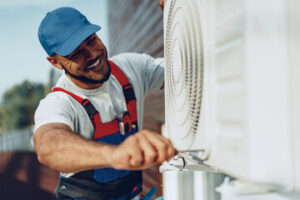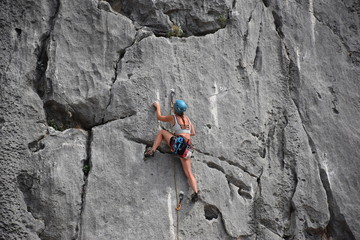We rely on our air conditioning systems to cool our homes, so when they break down, it can be very frustrating. But, by understanding the basics of how your AC system functions, you can feel more confident during the AC Repair process.
 Run capacitors are control centers that provide power to the compressor and evaporator coil. Without the proper power, your AC won’t start cooling. Contact AC Repair Round Rock TX for professional help.
Run capacitors are control centers that provide power to the compressor and evaporator coil. Without the proper power, your AC won’t start cooling. Contact AC Repair Round Rock TX for professional help.
Clogged filters can seriously compromise the efficiency and lifespan of an HVAC system. In addition, they can also lead to a number of other problems, from uneven heating and cooling to costly energy bills. Preventing clogged filters is one of the easiest ways to ensure that your system stays in top shape.
Your air filter is a fibrous material that captures dust, lint and other debris. Located in the return air duct or blower compartment of your HVAC system, these filters must be changed regularly to prevent them from becoming overloaded with debris. This is a simple task that most homeowners can perform themselves, and we recommend marking your calendar or setting reminders on your smartphone to remind yourself to check and replace the filter every month.
A clogged filter restricts the flow of air through your air conditioner, making it difficult to keep the entire house evenly cooled. This can also cause the system to overheat, which will result in higher maintenance and repair costs.
In some cases, a clogged filter can actually damage the evaporator coils. This is because the refrigerant must circulate through the evaporator coils to absorb heat from the air. As the airflow over these coils becomes restricted by a dirty filter, it becomes difficult for the coils to absorb heat and the system will eventually stop working entirely.
To avoid this problem, always ensure that the vents and ductwork are free of any obstructions. You can also clean your reusable filter by using a vacuum cleaner attachment, brush or running it under water thoroughly. Be sure to allow your filter to dry completely before reinstalling it. You can also test the effectiveness of your filter by hanging a white sheet near your vents. As the hot air blows to the sheet, it will blow any debris stuck in the filter back out of the vents and ductwork.
The coils in your outdoor air conditioning unit are key to its daily functioning. They’re made of copper and filled with refrigerant. The hot air from your home travels to the outside unit, where the coils absorb heat. The coils are then cooled and sent back inside to cool your home. If the coils are dirty, the whole system will suffer.
Dirty condenser coils make the AC system work harder to do its job, requiring more electricity and raising energy bills. This can also cause premature wear and tear on the system, reducing its lifespan.
The causes of dirty coils are many. Dust, dirt, weeds, cottonwood fuzz, pet hair, construction debris and seasonal pollen are just some of the contaminants that can coat your coils. These conditions can reduce the surface area of the coil, blocking proper air flow and elevating condensing temperatures and pressures.
One of the easiest ways to spot a dirty coil is to check your electricity bills. If you notice that your bills are higher than usual, it’s time to clean the coils.
If your coils are clogged with debris, you should clean them with a commercial AC cleaner. Avoid homemade cleaners as they can damage the coil’s exterior coating. Vinegar is an excellent DIY cleaner, but always follow the manufacturer’s instructions on how much to use and be sure to rinse the unit thoroughly afterward.
Cleaning the evaporator coil and fan is another easy AC maintenance chore you can do yourself. You can usually access the evaporator coil by removing the fan, which you can do with a screwdriver or drill. Just be sure to cut down weeds, grass and vines that may block the fan or interfere with airflow.
A leaking evaporator coil is the sign of an air conditioning system in need of professional AC repair. This is because this coil is where the heat from your home’s air is absorbed. A leaking coil allows this heat to escape, affecting your indoor air quality. A leaking evaporator coil can also lead to a higher energy bill and possibly shortening the lifespan of your AC unit. A leaking evaporator coil is not easy to fix, so it is important to keep up with regular preventive maintenance and air filter replacements.
A common cause of a leaking evaporator coil is corrosion. This is caused by the copper coils reacting with the water and chemicals found in household air. This reaction creates formic acid that eats away at the coils, creating small pinhole leaks over time. This can be exacerbated by high humidity levels, especially in coastal areas like Jacksonville. Chemicals in household cleaners, personal care products, and even pet urine can all contribute to a corroded evaporator coil.
Another reason for a leaking evaporator coil may be a lack of refrigerant. A leaking evaporator coil may indicate low refrigerant levels, which can affect how well your air conditioner works. It is important to have your air conditioner serviced by a licensed HVAC technician to ensure that your refrigerant levels are optimal for your system.
If you notice that your evaporator coil is dirty or iced over, it is a good idea to contact an HVAC professional for cleaning. A professional will be able to clean the coils without damaging them, while ensuring that they are in working condition. Regular cleanings will help to reduce the amount of corrosion and build-up on your coils, which can increase their lifespan and efficiency.
The compressor is the heart of your air conditioning system, pumping refrigerant throughout the unit to remove heat from your home. If this critical component stops working, the entire AC system will stop functioning. Luckily, there are many warning signs that your compressor is about to fail. Some are more obvious than others, such as loud noises or chemical leaks, but they are all worth paying attention to if you want to avoid costly AC repair costs.
A clicking sound as the compressor turns on and off can indicate that the start relay is bad. If you hear this noise repeatedly, it’s time to call for professional AC repair.
If the compressor’s circuit breaker trips repeatedly, it’s a sign that it is overheating or drawing too much power. It is important to avoid resetting the breaker, as this could turn the problem into a potential fire hazard. Instead, you should contact HVAC professionals to perform a detailed inspection of the compressor and your electrical circuit.
Seeing puddles of water around the compressor is another warning sign that it is about to fail. This could mean that the compressor is leaking or that it is low on refrigerant, which will cause your air conditioner to stop working.
If you notice a leak beside your compressor, it may be due to an incorrectly installed suction line. A professional can help you install a new one that is the correct size to prevent overheating and other damage. They can also tell you if it is worth repairing the compressor or if replacing it would make more sense. Repairing a compressor requires specialized manufacturing and can be extremely expensive, so it is usually more cost-effective to replace it.
While the thermostat is a relatively small part of an air conditioning system, it plays an important role in making sure that your cooling and heating equipment turns on when it’s needed. That’s why it’s so important to keep an eye out for signs that your thermostat is going bad.
If your thermostat display is unlit or the buttons don’t respond to input, it’s time for a new one. This can be due to a bad battery, or it could mean that there is an electrical problem with the unit. A bad thermostat may also cause your AC system to short-cycle, which means that it will turn on and off repeatedly rather than running continuously. This puts unnecessary stress on your compressor, which can cause it to burn out.
Thermostat sensors are responsible for determining when the temperature in your home has reached its set point. If your home feels warmer or colder than what the thermostat says, it is a sign that the sensors are damaged or out of alignment with the actual air temperature. You can test this by using a handheld ambient air thermometer to see if the reading matches your surroundings.
A broken thermostat can make it impossible for your heater or air conditioner to turn on. This can be caused by a variety of issues, from an aging sensor to faulty wiring connecting the thermostat to your heater and AC. Regardless of the cause, replacing your thermostat will restore functionality and prevent unnecessary strain on other components in your system. This is one of the main reasons why it’s so important to schedule regular maintenance with a local AC service provider.







 However, you can save money and avoid tripping hazards by calling for
However, you can save money and avoid tripping hazards by calling for